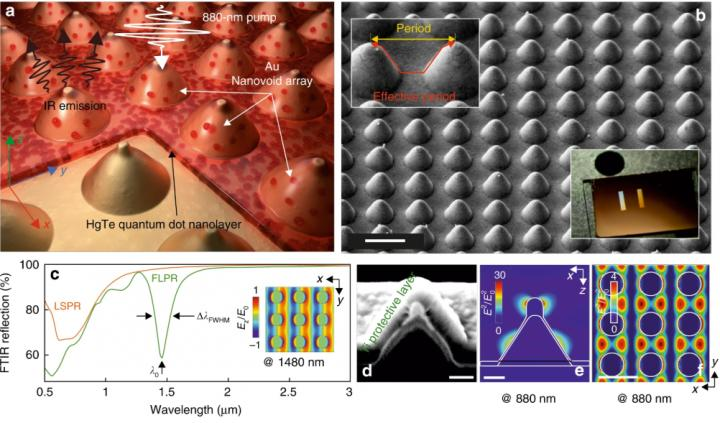Feb 7 2020
Ultra-compact bright sources created based on mercury telluride (HgTe) quantum dots (QDs) that emit IR have been manufactured by researchers at the Far Eastern Federal University (FEFU, Vladivostok, Russia), in collaboration with researchers from the Far Eastern Branch of the Russian Academy of Sciences (FEB RAS), Hong Kong, China, and Australia.
 (a) Artistic representation of the HgTe QD layer coated above the laser-printed Au nanobump array. (b) Side-view (view angle of 45°) SEM image showing the Au nanobump array printed at a 1-µm pitch (scale bar corresponds to 1 µm). (c) Typical Fourier transform infrared (FTIR) reflection spectrum of the plasmonic nanobump array printed at a 1-µm pitch (green curve). (d) Side-view (view angle of 70°) SEM image of the cross-section of the nanobump (scale bar is 200 nm). (e, f) Calculated EM-field intensity distribution (E2/E02) near the isolated nanobump (in the xz plane) and 50 nm above the smooth Au film level (in the xy plane) at an 880-nm pump wavelength (scale bars in (e, f) are 200 and 1000 nm, respectively). Image Credit: FEFU press office.
(a) Artistic representation of the HgTe QD layer coated above the laser-printed Au nanobump array. (b) Side-view (view angle of 45°) SEM image showing the Au nanobump array printed at a 1-µm pitch (scale bar corresponds to 1 µm). (c) Typical Fourier transform infrared (FTIR) reflection spectrum of the plasmonic nanobump array printed at a 1-µm pitch (green curve). (d) Side-view (view angle of 70°) SEM image of the cross-section of the nanobump (scale bar is 200 nm). (e, f) Calculated EM-field intensity distribution (E2/E02) near the isolated nanobump (in the xz plane) and 50 nm above the smooth Au film level (in the xy plane) at an 880-nm pump wavelength (scale bars in (e, f) are 200 and 1000 nm, respectively). Image Credit: FEFU press office.
These quantum dots are the prospective functional elements of advanced sensors and quantum computers. The study has been reported in an article published in Light: Science and Applications.
Working with researchers from the FEB RAS and foreign experts, the FEFU researchers developed a resonant lattice laser printed on a surface of thin gold film. This setup enables the near- and mid-IR radiation characteristics of capping layer of HgTe QDs to be controlled.
The near- and mid-IR spectral range holds excellent potential for implementing optical telecommunication devices, emitters, and detectors, apart from sensor and next-generation security systems.
The latest semiconductor QDs seem to be potential nanomaterials that emit light precisely in this range. But the main problem is related to the fundamental physical limitations (the Auger recombination, Fermi golden rule, etc.) that considerably decrease the intensity of the IR-emitting QDs.
Researchers from FEFU and Institute of Automation and Control Processes (IACP FEB RAS) collaborated with foreign colleagues and solved this problem, for the first time, by using a unique resonant lattice of nanostructures. Researchers developed the lattice by ultra-precise direct laser printing on the surface of a thin gold film.
The plasmon lattice we developed consists of millions of nanostructures arranged on the gold film surface. We produced such lattice using advanced direct laser processing. This fabrication technology is inexpensive comparing to existing commercial lithography-based methods, easily up-scalable, and allows facile fabrication of nanostructures over cm-scale areas.
Aleksander Kuchmizhak, Study Author and Researcher, FEFU Center for Virtual and Augmented Reality
Kuchmizhak continued, “This opens up prospects for applying the developed approach to design new optical telecommunication devices, detectors, and emitters, including the first IR-emitting QD-based microlaser.”
According to the researcher, the resonant lattice transforms the pump radiation into a unique kind of electromagnetic waves called surface plasmons. Such waves travel over the patterned gold film’s surface, inside the capping layer of QDs, thereby offering efficient excitation that boosts photoluminescence yield.
“For the visible spectral range, quantum dots have been synthesizing for several decades. Just a few scientific groups in the world, though, are capable of synthesizing QDs for the near and mid-IR range,” stated Alexander Sergeev, a senior researcher at IACP FEB RAS.
Thanks to the plasmon lattice we developed, which consists of plasmon nanostructures arranged in a special way, we are able to control the main light-emitting characteristics of such unique QDs, for example, by repeatedly increasing the intensity and photoluminescence lifetime, reducing the efficiency of non-radiative recombinations, as well as by tailoring and improving emission spectrum.
Alexander Sergeev, Senior Researcher, IACP FEB RAS
The researcher explained that quantum dots are a potential class of luminophores. They can be produced by a simple and low-cost chemical technique, last longer, and do not degrade like organic molecules.
The research was funded by grants from the Russian Science Foundation (No. 17-19-01325), the Center for Functional Photonics, City University of Hong Kong, and the Innovation and Technology Commission of the Government of Hong Kong (No. ITS / 402/17).